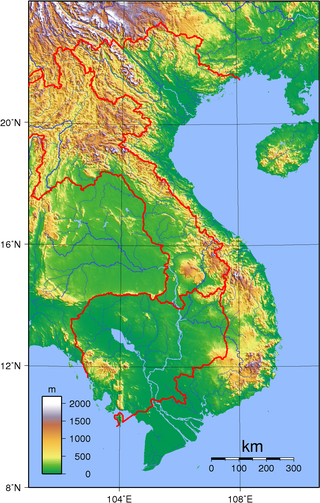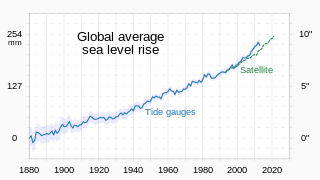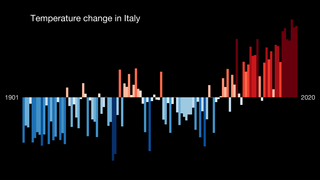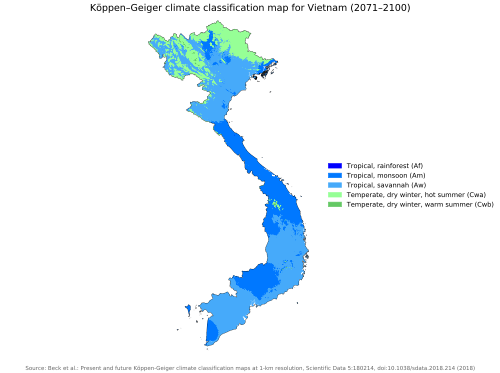
Vietnam is located on the eastern margin of the Indochinese peninsula and occupies about 331,211.6 square kilometres (127,881.5 sq mi), of which about 25% was under cultivation in 1987. It borders the Gulf of Tonkin, Gulf of Thailand, and Pacific Ocean, along with China, Laos, and Cambodia. The elongated roughly S shaped country has a north-to-south distance of 1,650 km (1,030 mi) and is about 50 km (31 mi) wide at the narrowest point. With a coastline of 3,260 km (2,030 mi), excluding islands, Vietnam claims 12 nautical miles as the limit of its territorial waters, an additional 12 nautical miles as a contiguous customs and security zone. It has an exclusive economic zone of 417,663 km2 (161,261 sq mi) with 200 nautical miles.

Climate change adaptation is the process of adjusting to the effects of climate change. These can be both current or expected impacts. Adaptation aims to moderate or avoid harm for people. It also aims to exploit opportunities. Humans may also intervene to help adjustment for natural systems. There are many adaptation strategies or options. They can help manage impacts and risks to people and nature. We can classify adaptation actions in four ways. These are infrastructural and technological; institutional; behavioural and cultural; and nature-based options.

Climate change in South Asia is having significant impacts already which are expected to intensify as global temperatures rise due to climate change. The South Asia region consists of the eight countries: Afghanistan, Pakistan, India, Nepal, Bhutan, Bangladesh, the Maldives and Sri Lanka. In the 2017 edition of Germanwatch's Climate Risk Index, Bangladesh and Pakistan ranked sixth and seventh respectively as the countries most affected by climate change in the period from 1996 to 2015, while India ranked fourth among the list of countries most affected by climate change in 2015. The Indian subcontinent is one of the most vulnerable regions globally to a number of direct and indirect effects of climate change, including sea level rise, cyclonic activity, and changes in ambient temperature and precipitation patterns. Ongoing sea level rise has already submerged several low-lying islands in the Sundarbans region, displacing thousands of people.
Climate change is an urgent and significant issue affecting Japan. In recent years, the country has observed notable changes in its climate patterns, with rising temperatures serving as a prominent indicator of this phenomenon. As an archipelago situated in northeastern Asia, Japan is particularly vulnerable to the impacts of climate change due to its diverse geography and exposure to various weather systems. The nation experiences a broad range of climates, spanning from the frigid winters of Hokkaido to the subtropical climates of Okinawa. Changes in temperature patterns have the potential to disrupt ecosystems, impact agricultural productivity, modify water resources, and pose significant challenges to infrastructure and human settlements.

Between 1901 and 2018, the average global sea level rose by 15–25 cm (6–10 in), or an average of 1–2 mm per year. This rate accelerated to 4.62 mm/yr for the decade 2013–2022. Climate change due to human activities is the main cause. Between 1993 and 2018, thermal expansion of water accounted for 42% of sea level rise. Melting temperate glaciers accounted for 21%, with Greenland accounting for 15% and Antarctica 8%. Sea level rise lags changes in the Earth's temperature. So sea level rise will continue to accelerate between now and 2050 in response to warming that is already happening. What happens after that will depend on what happens with human greenhouse gas emissions. Sea level rise may slow down between 2050 and 2100 if there are deep cuts in emissions. It could then reach a little over 30 cm (1 ft) from now by 2100. With high emissions it may accelerate. It could rise by 1 m or even 2 m by then. In the long run, sea level rise would amount to 2–3 m (7–10 ft) over the next 2000 years if warming amounts to 1.5 °C (2.7 °F). It would be 19–22 metres (62–72 ft) if warming peaks at 5 °C (9.0 °F).

Fisheries are affected by climate change in many ways: marine aquatic ecosystems are being affected by rising ocean temperatures, ocean acidification and ocean deoxygenation, while freshwater ecosystems are being impacted by changes in water temperature, water flow, and fish habitat loss. These effects vary in the context of each fishery. Climate change is modifying fish distributions and the productivity of marine and freshwater species. Climate change is expected to lead to significant changes in the availability and trade of fish products. The geopolitical and economic consequences will be significant, especially for the countries most dependent on the sector. The biggest decreases in maximum catch potential can be expected in the tropics, mostly in the South Pacific regions.

Climate change and poverty are deeply intertwined because climate change disproportionally affects poor people in low-income communities and developing countries around the world. The impoverished have a higher chance of experiencing the ill-effects of climate change due to the increased exposure and vulnerability. Vulnerability represents the degree to which a system is susceptible to, or unable to cope with, adverse effects of climate change including climate variability and extremes.
Although it is a country of high annual rainfall, irrigation in Vietnam is widespread. The reason is the uneven distribution of rainwater in space and in time. Irrigation management is mainly dominated by the state whereas there have been certain reforms leading to change during the last years. Awareness rising concerning environmental issues is starting to reach the people in Vietnam as well. Different strategies have been developed within the last decade to deal with environmental problems and mitigate possible impacts of climate change. With the implementation of different management structures taking into account the people's local needs, Vietnam is starting to follow Integrated Water Resources Management principles.

Climate change is a critical issue in Bangladesh as the country is one of the most vulnerable to the effects of climate change. In the 2020 edition of Germanwatch's Climate Risk Index, it ranked seventh in the list of countries most affected by climate calamities during the period 1999–2018. Bangladesh's vulnerability to the effects of climate change is due to a combination of geographical factors, such as its flat, low-lying, and delta-exposed topography, and socio-economic factors, including its high population density, levels of poverty, and dependence on agriculture. The impacts and potential threats include sea level rise, temperature rise, food crises, droughts, floods, and cyclones.

Climate change in Pakistan is a major issue for the country. Pakistan is highly vulnerable to climate change. As with the changing climate in South Asia as a whole, the climate of Pakistan has changed over the past several decades, with significant impacts on the environment and people. In addition to increased heat, drought and extreme weather in parts of the country, the melting of glaciers in the Himalayas has impacted some of the important rivers of Pakistan. Between 1999 and 2018, Pakistan ranked 5th in the countries affected by extreme weather caused by climate change. Pakistan is prone to a range of natural disasters, including cyclones, floods, drought, intense rainfall, and earthquakes. According to scientific research, climate change played a substantial role in the devastating floods of 2022, which had a direct impact on over 30 million people in Pakistan, resulting in the loss of lives, damage to public infrastructure, and displacement from homes. Climate change poses a significant menace to Pakistan's economy and security.

The effect of climate change on small island countries can be extreme because of low-lying coasts, relatively small land masses, and exposure to extreme weather. The effects of climate change, particularly sea level rise and increasingly intense tropical cyclones, threaten the existence of many island countries, island peoples and their cultures, and will alter their ecosystems and natural environments. Several Small Island Developing States (SIDS) are among the most vulnerable nations to climate change.

Climate change has had large impacts on the ecosystems and landscapes of the US territory Puerto Rico. According to a 2019 report by Germanwatch, Puerto Rico is the most affected by climate change. The territory's energy consumption is mainly derived from imported fossil fuels.

Climate change is having serious impacts in the Philippines such as increased frequency and severity of natural disasters, sea level rise, extreme rainfall, resource shortages, and environmental degradation. All of these impacts together have greatly affected the Philippines' agriculture, water, infrastructure, human health, and coastal ecosystems and they are projected to continue having devastating damages to the economy and society of the Philippines.
Climate change in Somalia refers to changes in the climate in Somalia and the subsequent response, adaption and mitigation strategies of the country.

Climate change in Senegal will have wide reaching impacts on many aspects of life in Senegal. Climate change will cause an increase in average temperatures over west Africa by between 1.5 and 4 °C by mid-century, relative to 1986–2005. Projections of rainfall indicate an overall decrease in rainfall and an increase in intense mega-storm events over the Sahel. The sea level is expected to rise faster in West Africa than the global average. Although Senegal is currently not a major contributor to global greenhouse gas emissions, it is one of the countries most vulnerable to climate change.

Climate change is posing an increasing threat to global socio-economic development and environmental sustainability. Developing countries with low adaptive capacity and high vulnerability to the phenomenon are disproportionately affected. Climate change in Kenya is increasingly impacting the lives of Kenya's citizens and the environment. Climate Change has led to more frequent extreme weather events like droughts which last longer than usual, irregular and unpredictable rainfall, flooding and increasing temperatures.
Climate change has caused temperatures in the world to rise in the last few decades, and temperatures in Europe have risen twice as fast as the average change in the rest of the world. In Spain, which already has a hot and dry climate, extreme events such as heatwaves are becoming increasingly frequent. The country is also experiencing more episodes of drought and increased severity of these episodes. Water resources will be severely affected in various climate change scenarios.

In Italy, widespread impacts of climate change are currently being felt. With an increase in extreme events such as heatwaves, droughts and more frequent flooding, Italy faces many challenges adapting to climate change.

India is ranked fourth among the list of countries most affected by climate change in 2015. India emits about 3 gigatonnes (Gt) CO2eq of greenhouse gases each year; about two and a half tons per person, which is less than the world average. The country emits 7% of global emissions, despite having 17% of the world population. Temperature rises on the Tibetan Plateau are causing Himalayan glaciers to retreat, threatening the flow rate of the Ganges, Brahmaputra, Yamuna and other major rivers. A 2007 World Wide Fund for Nature (WWF) report states that the Indus River may run dry for the same reason. Heat waves' frequency and intensity are increasing in India because of climate change. Severe landslides and floods are projected to become increasingly common in such states as Assam. The climate change performance index of India ranks eighth among 63 countries which account for 92% of all GHG emissions in the year 2021.

Climate change in the Middle East and North Africa (MENA) refers to changes in the climate of the MENA region and the subsequent response, adaption and mitigation strategies of countries in the region. In 2018, the MENA region emitted 3.2 billion tonnes of carbon dioxide and produced 8.7% of global greenhouse gas emissions (GHG) despite making up only 6% of the global population. These emissions are mostly from the energy sector, an integral component of many Middle Eastern and North African economies due to the extensive oil and natural gas reserves that are found within the region. The region of Middle East is one of the most vulnerable to climate change. The impacts include increase in drought conditions, aridity, heatwaves and sea level rise.

![Change in annual average temperature (degC) during the last 52 years in Vietnam [source MONRE (2012a, b)] Change in annual average temperature (degC) during the last 52 years in Vietnam.png](http://upload.wikimedia.org/wikipedia/commons/thumb/5/51/Change_in_annual_average_temperature_%28%C2%B0C%29_during_the_last_52_years_in_Vietnam.png/220px-Change_in_annual_average_temperature_%28%C2%B0C%29_during_the_last_52_years_in_Vietnam.png)


![Change in precipitation (%) during the last 52 years in Vietnam [source MONRE (2012a, b)] Precipitation.png](http://upload.wikimedia.org/wikipedia/commons/thumb/9/94/Precipitation.png/220px-Precipitation.png)

![Change in sea level based on data from measuring stations (1960-2010) [source MONRE (2009, 2012a, b)] SLR in Vietnam.png](http://upload.wikimedia.org/wikipedia/commons/thumb/2/24/SLR_in_Vietnam.png/220px-SLR_in_Vietnam.png)


















